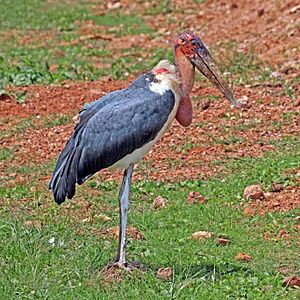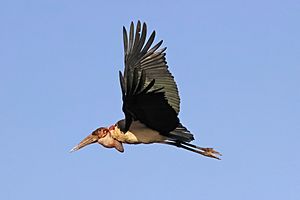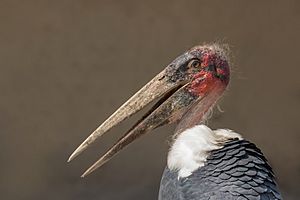Marabou stork facts for kids
Quick facts for kids Marabou stork |
|
|---|---|
 |
|
| Uganda | |
 |
|
| Ethiopia | |
| Conservation status | |
| Scientific classification | |
 |
|
| Synonyms | |
|
The marabou stork (Leptoptilos crumenifer) is a very large bird that lives in sub-Saharan Africa. It is part of the stork family, called Ciconiidae. These birds can be found in both wet and dry places. They often live close to people, especially near landfill sites where they can find food. Some people call it the "undertaker bird". This is because of how it looks from behind. Its wings and back look like a cloak, and it has thin white legs. It also sometimes has a large white "hair" mass.
Contents
About the Marabou Stork
What's in a Name?
The marabou stork was first officially described in 1831. A French scientist named René Lesson gave it its scientific name. He placed it in the stork group called Ciconia. Its first scientific name was Ciconia crumenifera.
Now, this stork is in a different group called Leptoptilos. This group also includes the lesser adjutant and greater adjutant storks. The marabou stork is a monotypic species. This means there are no different types or subspecies of it.
The common name "marabou" might come from an Arabic word. The word murābit means quiet or hermit-like. The scientific name crumenifer means "carrier of a pouch for money". This refers to the pouch on its throat.
How to Spot a Marabou Stork
The marabou stork is a huge bird, so it's easy to recognize. Large ones can stand up to 152 centimeters (5 feet) tall. They can weigh around 9 kilograms (20 pounds). Their wingspan can be very wide, sometimes over 3 meters (10 feet). Some reports even say up to 4 meters (13 feet), but these are hard to confirm.
Most marabou storks have a wingspan between 225 and 287 centimeters (7.4 to 9.4 feet). Their typical weight is 4.5 to 8 kilograms (9.9 to 17.6 pounds). From bill to tail, they are usually 120 to 130 centimeters (47 to 51 inches) long. Female storks are a bit smaller than males. Their large bills can be 26.4 to 35 centimeters (10.4 to 13.8 inches) long.
Unlike most storks, marabous fly with their necks pulled back. This is similar to how herons fly. They have a bare head and neck, which are not covered in feathers. Their back is black, and their belly is white. They also have a pink pouch on their throat. Young birds are browner and have smaller bills. They become fully grown after about four years.
Life and Habits
Like many storks, marabous like to live in groups. They also breed in colonies, meaning many pairs nest together. They build their nests in trees during Africa's dry season. This is when food is easier to find. They usually lay two or three eggs in their nest. Marabou storks are known to be quite ill-tempered.
They are not very noisy birds. But during courtship displays, they make sounds by rattling their bills. They also use their throat pouch to make different noises at this time.
Reproduction and Life Cycle
Marabou storks breed in Africa, south of the Sahara Desert. In East Africa, they often breed in cities, close to people. In southern Africa, they prefer less populated areas. They start breeding in colonies during the dry season.
The female stork lays two to three eggs in a small nest made of sticks. The eggs hatch after about 30 days. Young storks become ready to have their own babies at 4 years old. Marabou storks can live for about 43 years in zoos. In the wild, they usually live for about 25 years.
What They Eat
Marabou storks are often scavengers. This means they eat dead animals. Their bare head and long neck help them with this. It's like vultures, which also eat dead animals. If their heads had feathers, they would get messy with blood. A bare head is much easier to keep clean.
These big, strong birds mainly eat carrion (dead animals), scraps, and animal waste. But they will eat almost any animal matter they can swallow. Sometimes, they eat other birds, like baby Quelea, pigeons, doves, and even flamingos. They also eat baby pelicans and cormorants.
During the time they are raising their young, adult storks eat less dead meat. They mostly catch small, live prey for their babies. This food helps the young storks grow. They might eat fish, frogs, insects, eggs, small mammals, and reptiles. This includes baby crocodiles, crocodile eggs, lizards, and snakes. Even though they eat rotten food, they sometimes wash their food in water to clean off dirt.
When eating dead animals, marabous often follow vultures. Vultures have strong, hooked bills that can tear through tough meat. Marabous might wait for vultures to drop a piece of meat. They might also steal food directly from a vulture. Or they wait until the vultures are finished eating. Like vultures, marabou storks help clean up nature by eating dead animals and waste.
More and more, marabous are relying on human garbage for food. Hundreds of these huge birds can be seen around African garbage dumps. They also wait for food handouts in cities. Marabous eating human garbage have been seen to swallow almost anything. This includes things like shoes and pieces of metal. Storks that are used to getting food from people can become aggressive if they are refused food.
Natural Threats
Adult marabou storks have very few natural enemies. They have a good chance of surviving each year. However, there have been reports of lions hunting and eating some storks.
Scientists have found some small creatures living inside wild marabous. These are called endoparasites. They include different types of worms.
Human Uses
Marabou feathers, especially the soft down, are often used. They are used to decorate clothes and hats. They are also used to make fishing lures. Sometimes, turkey feathers are used instead of real marabou feathers.
In some card games like tarot and tarock, the Marabou is part of a group called "the Birds". Other birds in this group include the Sparrow, Eagle Owl, and Cockatoo. Sometimes, the Dodo is also included.
Images for kids
-
A marabou stork and Griffon vultures scavenging in the Masai Mara, Kenya
-
A marabou stork spreading its wings in Uganda
See also
 In Spanish: Marabú africano para niños
In Spanish: Marabú africano para niños












